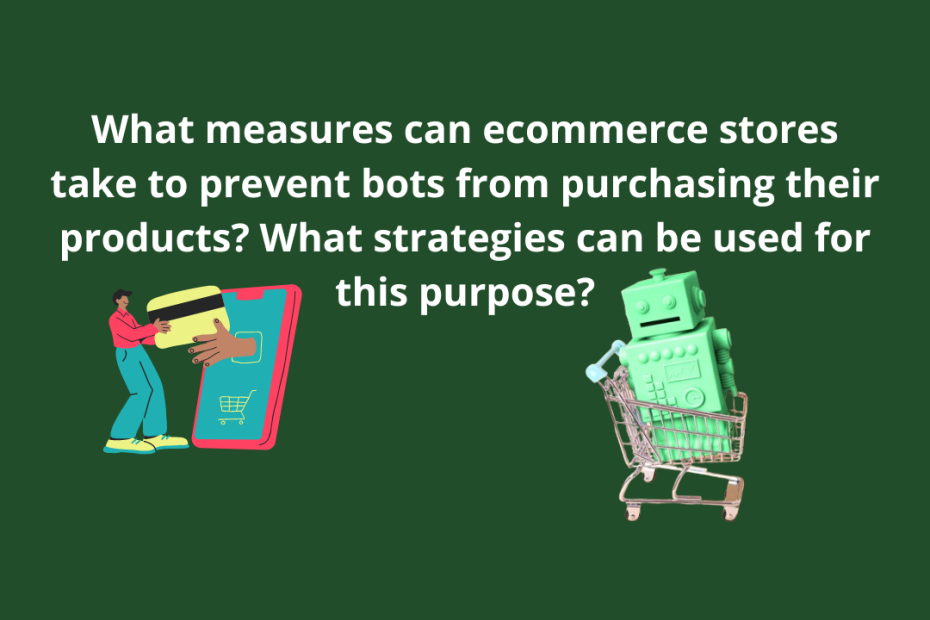E-commerce stores can implement several measures and strategies to prevent bots from purchasing their products. Here are some effective methods:
1. CAPTCHA and reCAPTCHA
- CAPTCHA (Completely Automated Public Turing test to tell Computers and Humans Apart): Implementing CAPTCHA tests at critical points such as login, registration, and checkout can help differentiate between bots and humans.
- reCAPTCHA: Google’s reCAPTCHA is a popular and advanced option that adapts the complexity of the challenge based on the perceived threat level, providing a better user experience while blocking bots.
2. Rate Limiting
- Request Rate Limiting: Restrict the number of requests a user (or IP address) can make in a given time frame to prevent bots from overwhelming the site with rapid requests.
- Dynamic Rate Limiting: Adjust limits dynamically based on traffic patterns and user behavior to provide more flexibility and accuracy in blocking malicious activity.
3. Behavioral Analysis
- User Behavior Monitoring: Analyze user behavior patterns to identify abnormal activities such as rapid clicks, consistent browsing speeds, and non-human interaction patterns.
- Machine Learning Models: Use machine learning to build models that can predict and detect bot behavior by analyzing large datasets of legitimate and illegitimate activities.
4. IP Address Filtering
- Blacklist Suspicious IPs: Maintain and update a blacklist of known malicious IP addresses.
- Geofencing: Block or challenge traffic from regions where legitimate traffic is unlikely or from which a high volume of bot traffic originates.
5. Device Fingerprinting
- Unique Identifiers: Use device fingerprinting to identify unique characteristics of devices accessing the site. This can help detect when the same device is making numerous requests.
- Cross-Session Tracking: Track devices across sessions to identify suspicious patterns indicative of bot activity.
6. Honeypots
- Hidden Fields: Add invisible form fields that legitimate users won’t interact with. If these fields are filled out, it’s a strong indication of bot activity.
- Trap Pages: Create decoy pages or links that bots might follow, which can help in identifying and blocking them.
7. Multi-Factor Authentication (MFA)
- Two-Factor Authentication (2FA): Require users to verify their identity through a second method, such as a text message or authentication app, especially for sensitive actions like making purchases or accessing accounts.
8. Web Application Firewalls (WAF)
- Bot Management Solutions: Use WAFs with built-in bot management capabilities to filter out malicious traffic. Solutions like Cloudflare, Akamai, and Imperva offer advanced bot detection and mitigation features.
- Custom Rules: Configure custom rules to block or challenge traffic based on specific patterns indicative of bots.
9. JavaScript Challenges
- Bot Protection Scripts: Deploy JavaScript challenges that are easy for humans to solve but difficult for bots, such as requiring the browser to execute complex scripts.
10. User Verification
- Email and SMS Verification: Require users to verify their email addresses and phone numbers during the account creation process to ensure they are legitimate.
11. Rate Limiting and Session Management
- Limit Account Creations: Restrict the number of accounts that can be created from a single IP address within a specific time frame.
- Session Timeout: Implement session timeouts to log out inactive users, preventing bots from maintaining prolonged sessions.
12. Monitoring and Analytics
- Real-Time Monitoring: Continuously monitor site traffic and user interactions in real-time to detect and respond to bot activity promptly.
- Detailed Analytics: Use analytics tools to gain insights into traffic patterns and identify anomalies that may indicate bot activity.
13. Server-Side Techniques
- Rate Limiting on Server: Implement server-side rate limiting to control the frequency of requests.
- Dynamic Content Generation: Serve dynamically generated content that can change with each request, making it harder for bots to scrape or interact with the site.
14. Access Control
- Credential Stuffing Protection: Use solutions that detect and block credential stuffing attacks, where bots try to log in with stolen username-password pairs.
- Account Lockout Mechanisms: Temporarily lock accounts after a certain number of failed login attempts to prevent automated brute-force attacks.
Conclusion
Implementing a combination of these strategies can significantly reduce the risk of bots purchasing products on an e-commerce site. Each e-commerce platform has unique requirements and constraints, so it’s important to tailor the approach to the specific needs of the business.
For businesses using PrestaShop, PrestaTuts.com offers expert services to help implement these anti-bot measures effectively, ensuring a secure and smooth shopping experience for legitimate customers.
